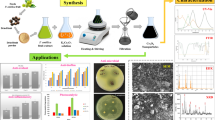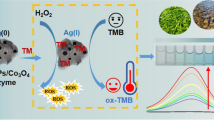Abstract
The focus of this paper is laid on synthesizing layered compounds of CuMoO4 and Ti3C2Tx using a simple wet chemical etching method and sonochemical method to enable rapid detection of rutin using an electrochemical sensor. Following structural examinations using XRD, surface morphology analysis using SEM, and chemical composition state analysis using XPS, the obtained CuMoO4/Ti3C2Tx nanocomposite electrocatalyst was confirmed and characterized. By employing cyclic voltammetry and differential pulse voltammetry, the electrochemical properties of rutin on a CuMoO4/Ti3C2Tx modified electrode were examined, including its stability and response to variations in pH, loading, sweep rate, and interference. The CuMoO4/Ti3C2Tx modified electrode demonstrates rapid rutin sensing under optimal conditions and offers a linear range of 1 µΜ to 15 µΜ, thereby improving the minimal detection limit (LOD) to 42.9 nM. According to electrochemical analysis, the CuMoO4/Ti3C2Tx electrode also demonstrated cyclic stability and long-lasting anti-interference capabilities. The CuMoO4/Ti3C2Tx nanocomposite demonstrated acceptable recoveries when used to sense RT in apple and grape samples. In comparison to other interfering sample analytes encountered in the current study, the developed sensor demonstrated high selectivity and anti-interference performance. As a result, our research to design of high-performance electrochemical sensors in the biomedical and therapeutic fields.
Graphical abstract













Similar content being viewed by others
References
Asad Ullah S, Munir SL, Badshah N, Khan L, Ghani BG, Poulson Abdul-Hamid Emwas and Mariusz Jaremko, (2020), important flavonoids and their role as a therapeutic Agent. Molecules, 25, 5243. https://doi.org/10.3390/molecules25225243
Aditya Ganeshpurkar AK, Saluja (2017) The pharmacological potential of Rutin, SPJ. 25:149–164. https://doi.org/10.1016%2Fj.jsps.2016.04.025
Ahmet Şenocaka A, Khataee E, Demirbasa E, Doustkhah (2020) Ultrasensitive detection of rutin antioxidant through a magnetic micro-mesoporous graphitized carbon wrapped Co nanoarchitecture, Sens. Actuators B Chem 312:127939. https://doi.org/10.1016/j.snb.2020.127939
Apurva D, Patil, Pramod J, Kasabe, Dandge PB (2022) Pharmaceutical and nutraceutical potential of natural bioactive pigment: astaxanthin. Nat prod Bioprospect 12(1):25. https://doi.org/10.1007/s13659-022-00347-y
Mawethu Pascoe Bilibana (2023) Electrochemical properties of MXenes and applications, ASEM, 2, 100080. https://doi.org/10.1016/j.asems.2023.100080
Kalambate PK, Gadhari NS, Rao Z, Navale ST, Shen Y, Patil VR, Huang Y (2019) Recent advances in MXene–based electrochemical sensors and biosensors, TrAC. Trends Anal Chem 120:115643. https://doi.org/10.1016/j.trac.2019.115643
Govindasamy M, Wang SF, Huang CH, Alshgari RA, Ouladsmane M (2022) Colloidal synthesis of perovskite-type lanthanum aluminate incorporated graphene oxide composites: Electrochemical detection of nitrite in meat extract and drinking water. Microchim Acta 189:210. https://doi.org/10.1007/s00604-022-05296-4
Jaysiva Ganesamurthi R, Shanmugam SM, Chen K, Alagumalai M, Balamurugan Y-Y, Yu (2022) Binary transition metal oxide based electrochemical sensor for the evaluation of chlorogenic acid in real-time samples,mater. Chem Phys https://doi.org/10.1016/j.matchemphys.2022.126757
Guangjun Feng Y, Yang J, Zeng J, Zhu J, Liu L, Wu Z, Yang G, Yang Q, Mei Q, Chen, Fengying, Ran (2022) Highly sensitive electrochemical determination of rutin based on the synergistic effect of 3D porous carbon and cobalt tungstate nanosheets. J Pharm Anal 12(3):453–459. https://doi.org/10.1016%2Fj.jpha.2021.09.007
Ananya S, Agnihotri A, Varghese, Nidhin M (2021) Transition metal oxides in electrochemical and bio sensing: a state-of-art review. Appl Surf Sci Adv 4:100072. https://doi.org/10.1016/j.apsadv.2021.100072
Palanisamy, Kannan, Maduraiveeran G (2023) Metal Oxides Nanomaterials and Nanocomposite-Based Electrochemical Sensors for Healthcare Applications, Biosensors, 13, 542. https://doi.org/10.3390/bios13050542
Lu Y, Hu J, Zeng Y, Zhu Y, Wang H, Lei X, Huang S, Guo L, Li L (2020) Electrochemical determination of rutin based on molecularly imprinted poly (ionic liquid) with ionic liquid-graphene as a sensitive element, Sens. Actuators B Chem 311:127911. https://doi.org/10.1016/j.snb.2020.127911
Balasubramanian P, Annalakshmi M, Chen SM, Chen TW (2019) Sonochemical synthesis of molybdenum oxide (MoO3) microspheres anchored graphitic carbon nitride (g-C3N4) ultrathin sheets for enhanced electrochemical sensing of Furazolidone. Ultrason Sonochem 50:96–104. https://doi.org/10.1016/j.ultsonch.2018.09.006
Xi J, Wang H, Zhang B, Zhao F, Zeng B (2020) Novel molecularly imprinted photoelectrochemical sensor for rutin based on Bi2S3/ZnIn2S4 heterojunction, Sens. Actuators B Chem 320:128409. https://doi.org/10.1016/j.snb.2020.128409
Niu X, Wen Z, Li X, Zhao W, Li X, Huang Y, Li Q, Li G, Sun W (2018) Fabrication of graphene and gold nanoparticle modified acupuncture needle electrode and its application in rutin analysis. Sens Actuators B Chem 255:471–477. https://doi.org/10.1016/j.snb.2017.07.085
Zhang R, Liu J, Li Y (2019) MXene with great Adsorption ability toward Organic Dye: an excellent material for constructing a Ratiometric Electrochemical sensing platform. ACS Sens 4:8, 2058–2064. https://doi.org/10.1021/acssensors.9b00654
Khan MA, Ramzan F, Ali M, Zubair M, Muhammad Qasim Mehmood and, Massoud Y (2023) Emerging Two-Dimensional Materials-Based Electrochemical Sensors for Human Health and Environment Applications, Nanomaterials, 13, 780. https://doi.org/10.3390/nano13040780
Lenka Lorencova T, Bertok J, Filip M, Jerigova D, Velic P, Kasak KA, Mahmoud J, Tkac (2018) Highly stable Ti3C2Tx (MXene)/Pt nanoparticles-modified glassy carbon electrode for H2O2 and small molecules sensing applications, Sens. Actuators B Chem., 15, 360–368. https://doi.org/10.1016/j.snb.2018.02.124
Sun B, Lv H, Liu Z, Wang J, Bai X, Zhang Y, Chen J, Kan K, Shi K (2021) Co3O4@PEI/Ti3C2Tx MXene nanocomposites for a highly sensitive NOx gas sensor with a low detection limit. J Mater Chem A 9:6335–6344. https://doi.org/10.1039/D0TA11392A
Vedhanarayanan B, Praveen VK, Das G, Ajayaghosh A (2018) Hybrid materials of 1D and 2D carbon allotropes and synthetic π-systems. NPG Asia Mater 10:107–126. https://doi.org/10.1038/s41427-018-0017-6
Liu F, Chen X, Wang X, Han Y, Song X, Tian J, He X, Cui H (2019) Fabrication of 1D Zn2SnO4 nanowire and 2D ZnO nanosheet hybrid hierarchical structures for use in triethylamine gas sensors. Sens Actuators B Chem 291:155–163. https://doi.org/10.1016/j.snb.2019.04.009
Alagh A, Annanouch FE, Umek P, Bittencourt C, Castillo AS, Haye E, Colomer JF, Llobet E (2021) CVD growth of self-assembled 2D and 1D WS2 nanomaterials for the ultrasensitive detection of NO2, Sens. Actuators B Chem 326:128813. https://doi.org/10.1021/acsami.2c16299
Ezhil Vilian AT, Hwang S-K, Bhaskaran G, Alhammadi M, Kim S, Tiwari JN, Huh YS, Han Y-K (2023) Polypyrrole-MXene supported gold nanoparticles for the trace-level detection of nitrofurantoin. J Chem Eng 454:139980. https://doi.org/10.1016/j.cej.2022.139980
Sonali A, Beknalkar AM, Teli AC, Khot, Sagar M Mane Jae Cheol Shin, (2023), Preparation of CuMn2O4/Ti3C2 MXene composite electrodes for supercapacitors with high energy density and study on their charge transfer kinetics. Ceram Int 49, 19, 31236–31236. https://doi.org/10.1016/j.ceramint.2023.07.071
Kugalur S, Ranjith AT, Ezhil Vilian SM, Ghoreishian R, Umapathi YS, Huh Y-K, Han (2021) An ultrasensitive electrochemical sensing platform for rapid detection of rutin with a hybridized 2D-1D MXene-FeWO4 nanocomposite, Sens. Actuators B Chem 344:130202. https://doi.org/10.1016/j.snb.2021.130202
Lite Yang J, Yang B, Xu F, Zhao B, Zeng (2016) Facile preparation of molecularly imprinted polypyrrole-graphene multiwalled carbon nanotubes composite film modified electrode for rutin sensing. Talanta 161:413–418. https://doi.org/10.1016/j.talanta.2016.08.080
Ningappa Kumara Swamy,Kikkeri Narasimha Shetty Mohana,Mahesh Bhaskar Hegde,Ambale Murthy Madhusudana, Kamalon Rajitha,Saurav Ramesh Nayak (2021) Fabrication of graphene nanoribbonbased enzymefree electrochemical sensor for the sensitive and selective analysis of rutin in tablets. J Appl Electrochem 51:1047–1057. https://doi.org/10.1007/s10800-021-01557-x
Beibei Yang D, Bin K, Zhang Y, Du T, Majima (2018) A seed-mediated method to design N-doped graphene supported gold silver nanothorns sensor for rutin detection. Colloid Interface Sci 512:446–454. https://doi.org/10.1016/j.jcis.2017.10.082
Xinsheng Liu W, Qiao M, Chang Y, Wang Y, Li (2203) Development of rutin sensor based on graphene quantum dots@ nanocarbon ionic liquid electrode. Ionics 29(8):1–8. https://doi.org/10.1007/s11581-023-04993-1
Jaouhari AE, Zhu LYJ, Zhao D, Md. Zaved Hossain Khan, Liu X (2020) enhanced molecular imprinted electrochemical sensor based on zeolitic imidazolate framework/reduced graphene oxide for highly recognition of rutin, Analytica Chimica Acta 1106, 103–114. https://doi.org/10.1016/j.aca.2020.01.039
Qingfang Zhen H, Ma Z, Jin D, Zhu X, Liu Y, Sun C, Zhang, Pang H (2021) Electrochemical sensor for rutin detection based on N-doped mesoporous carbon nanospheres and graphene. New J Chem 45:4986–4993. https://doi.org/10.1039/D1NJ00019E
Ahmet S, enocak, Vildan Sanko O, Tüma Y, Orooji E, Demirbas Y, Yoon A, Khataee (2022) Ultrasensitive electrochemical sensor for detection of rutin antioxidant by layered Ti3Al0.5Cu0.5C2 MAX phase, FCT, 164, 113016. https://doi.org/10.1016/j.fct.2022.113016
Subbarayan Sumithra N, Manjulaa S-M, Chen (2020) Simple synthesis of CoSn (OH)6 nanocubes for the rapid electrochemical determination of rutin in the presence of quercetin and acetaminophen. New J Chem 44:11271–11281. https://doi.org/10.1039/D0NJ01737J
Govindasamy M, Chen SM, Mani V, Sathiyan A, Merlin JP, Al-Hemaid FM, Ali MA (2016) Simultaneous determination of dopamine and uric acid in the presence of high ascorbic acid concentration using cetyltrimethylammonium bromide–polyaniline/activated charcoal composite. RSC Advances 6:00605–100613. https://doi.org/10.1039/C6RA18740D
He J-L, Yang YYaX, Liu Y-L, Liu Z-H, Shen G-L, Yu R-Q (2006) Cyclodextrin incorporated carbon nanotube-modified electrode as an electrochemical sensor for rutin. Sens Actuators B Chem 114:94–100. https://doi.org/10.1016/j.snb.2005.04.009
Praveen Kumar G, Raja Nehru S-M, Chen BM, Almunqedhi T-W, Chen J-Y, Wang M-C, Yu NM, Darwish (2019) Electrochemical Rutin Sensor based on Graphene Oxide and Functionalized Multiwall Carbon Nanotubes@nafion0.1% hybrid nanocomposite modified glassy carbon electrode. Int J Electrochem Sci 14:6066–6075. https://doi.org/10.20964/2019.07.54
Yang G, Yang Q, Mei Q, Chen F, Ran (2022) Highly sensitive electrochemical determination of rutin based on the synergistic effect of 3D porous carbon and cobalt tungstate nanosheets. J Pharm Anal 12:453–459. https://doi.org/10.1016/j.jpha.2021.09.007
Acknowledgements
This study was funded by the Ministry of Science and Technology of Taiwan under grant number 107-2221-E-131-011 and National Science and Technology Council of Taiwan under grant number 111-2811-E-131-003 and 111-2221-E-131-017-MY2 and Ming Chi University of Technology, Taiwan. This work was funded by the Researchers Supporting Project Number (RSP2024R243) King Saud University, Riyadh, Saudi Arabia. Author JR & AS thank RUSA 2.0, DST (FIST), SERB, DAE-BRNS, TANSCHE, and UGC-DAE-CSR, Indore providing financial support and instruments facility.
Author information
Authors and Affiliations
Corresponding authors
Ethics declarations
Competing interest
The authors declare that they have no known competing financial interests.
Additional information
Publisher’s Note
Springer Nature remains neutral with regard to jurisdictional claims in published maps and institutional affiliations.
Electronic supplementary material
Below is the link to the electronic supplementary material.
604_2024_6267_MOESM1_ESM.docx
Supplementary Material 1: Figure S1. (a) SEM Images of CuMoO4, and (b) Ti3C2Tx electrode materials. Table S1. Equivalent circuit fitted value for modified electrodes. Table S2. Determination of rutin in real juice samples by DPV method.
Rights and permissions
Springer Nature or its licensor (e.g. a society or other partner) holds exclusive rights to this article under a publishing agreement with the author(s) or other rightsholder(s); author self-archiving of the accepted manuscript version of this article is solely governed by the terms of such publishing agreement and applicable law.
About this article
Cite this article
Ramadoss, J., Govindasamy, M., Sonachalam, A. et al. CuMoO4/Ti3C2Tx nanocomposite layers perform as an ultrasensitive electrochemical sensor for the detection of antioxidant rutin. Microchim Acta 191, 226 (2024). https://doi.org/10.1007/s00604-024-06267-7
Received:
Accepted:
Published:
DOI: https://doi.org/10.1007/s00604-024-06267-7




